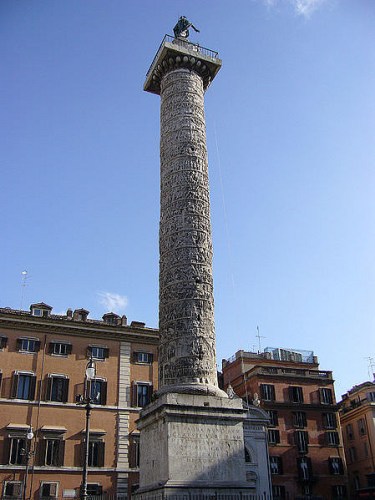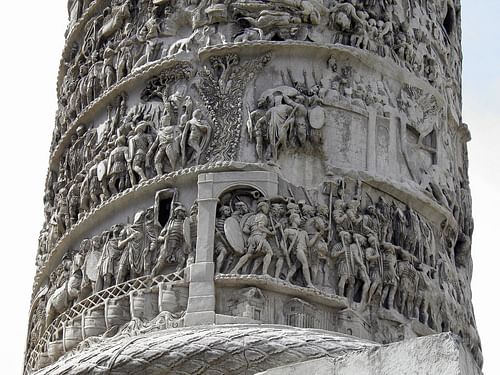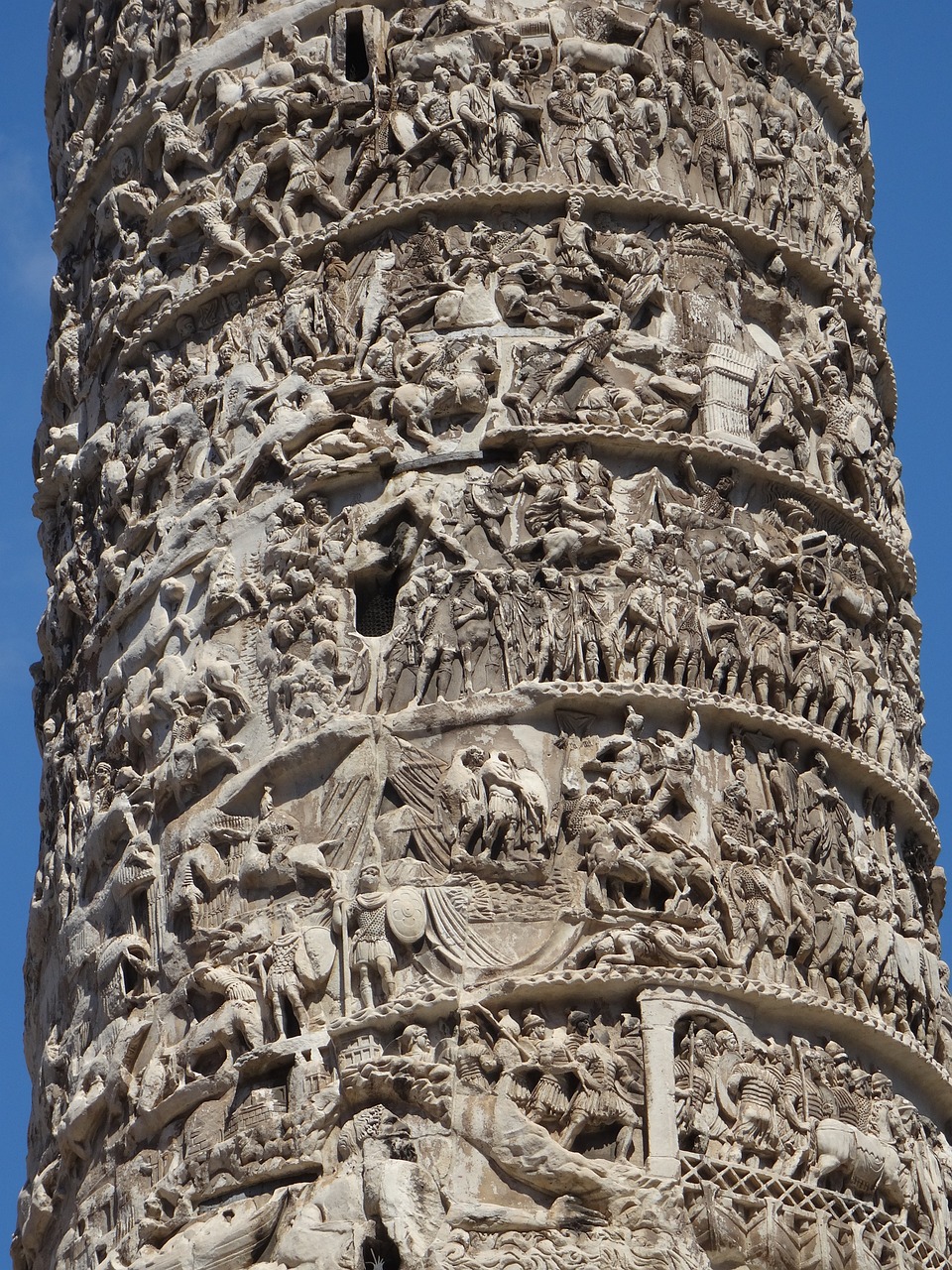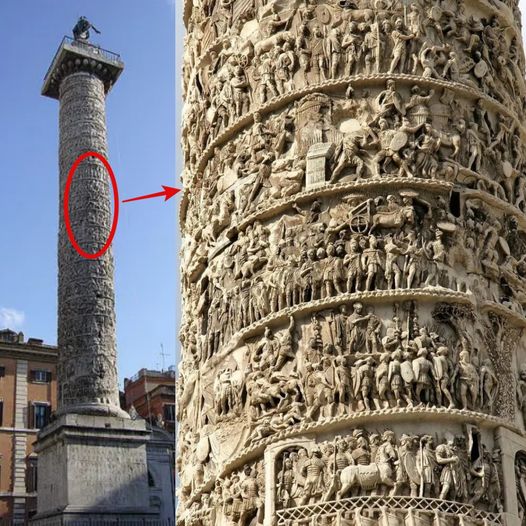Standing tall in the heart of Rome, the Column of Marcus Aurelius and Faustina is a captivating relic that transports us back to the glory days of the Roman Empire. This enigmatic monument, believed to have been erected around 180 CE by the emperor Commodus, serves as a testament to the military prowess and triumphs of his revered parents, Marcus Aurelius and Faustina.
Inspired by the renowned Trajan’s Column, the Column of Marcus Aurelius boasts an impressive height of 39 meters, with an additional 7 meters of its base structure yet to be excavated. Intricately carved in high relief, the column’s spiraling narratives vividly depict the emperor’s military campaigns against the Quadi, offering a glimpse into the strategic and logistical feats of Roman warfare.
In this blog post, we will delve into the fascinating history, intricate carvings, and the enduring legacy of this remarkable ancient structure, shedding light on the grandeur and artistry of the Roman Empire.
The Architectural Masterpiece
The Column of Marcus Aurelius stands as a testament to the architectural prowess of the Romans. Rising to an impressive height of 39 meters, the Doric column boasts a nearly straight profile, with a slight widening of only 14 centimeters at the base. This elegant design is complemented by the intricate relief carvings that adorn the column’s 21 spirals, each measuring an impressive 130 centimeters in height.

The column’s hollow core houses an ingeniously crafted spiral staircase, providing access to an upper viewing platform. Originally, a statue, most likely depicting the emperor himself, adorned the pinnacle of the column, further enhancing its towering stature. The recorded measurement of 51.95 meters (or 175 Roman feet) mentioned in the 4th-century CE Regional Catalogues suggests that the column’s full height, including the base and the statue, was truly awe-inspiring.
Interestingly, the locals often referred to the column as the “Centenaria,” a name derived from its impressive height, immediate base, and capital, which collectively measured 100 Roman feet (29.6 meters). This designation highlights the immense scale and grandeur of the monument, which must have been a striking sight in the ancient cityscape of Rome.
The Narrative of Conquest

The intricate relief carvings adorning the column’s spirals tell a captivating story of the military campaigns led by Marcus Aurelius in the territories north of the Danube. The first campaign, portrayed on the lower part of the column, depicts the encounters with the Marcomanni in 172-173 CE, while the second campaign, showcased on the upper part, showcases the conflicts with the Sarmatians in 174-175 CE.
The carvings are executed in high relief, providing a vivid and dynamic representation of the events. The scenes range from intense battlefield encounters to intriguing background details, such as the emperor addressing his troops and the logistical feats of the Roman military operations. One particularly striking relief portrays the troops crossing a pontoon bridge, highlighting the engineering and tactical prowess of the Roman legions.
The artistic style of the reliefs exemplifies the characteristic features that would come to dominate Late Antiquity sculpture. The emphasis is on frontal views, with perspective achieved by arranging smaller figures in rows above the foreground. The proportions of the figures are slightly distorted, with heads often rendered larger and bodies either shorter or elongated, while facial features are minimized. This distinctive style adds to the captivating and almost cinematic quality of the carvings, transporting the viewer back in time to witness the unfolding of these historic military campaigns.
The Trials and Tribulations

Like many ancient monuments, the Column of Marcus Aurelius has endured the ravages of time and the changing whims of humanity. The intricate relief carvings, executed in higher relief compared to Trajan’s Column, have suffered significant deterioration due to weathering and environmental factors.
Over the centuries, the column has also faced numerous challenges, from lightning strikes and earthquakes to the removal of the valuable pins that held the various drums of the column in place during the Middle Ages. This latter intervention led to several sections of the column shifting dramatically over time, compromising its structural integrity.
Despite these setbacks, the column has undergone significant restoration efforts, most notably under the direction of Pope Sixtus V in 1589 CE. During this restoration, the pedestal was reconfigured to accommodate changes in ground level, and a bronze statue of St. Paul was placed atop the column, replacing the original imperial figure.
However, not all of the restoration work has been met with universal acclaim. The removal of the sculptures depicting conquered barbarians and Victories that once adorned the column’s upper section has been a source of controversy and debate among historians and art enthusiasts. Additionally, the use of grey Proconnesian marble to fill in damaged areas stands in stark contrast to the original fine white marble, serving as a visible reminder of the changes and interventions the column has undergone throughout its history.
The Enduring Legacy

Despite the trials and tribulations it has faced, the Column of Marcus Aurelius remains a captivating and enigmatic monument that continues to captivate visitors from around the world. Its sheer size, intricate carvings, and the powerful narratives they convey make it a testament to the grandeur and military prowess of the Roman Empire.
As we gaze upon this towering structure, we are transported back in time, witnessing the strategic brilliance and engineering feats of the Roman legions. The column’s ability to evoke a sense of awe and wonder is a testament to the enduring legacy of the Roman civilization, which continues to shape our understanding of the past and inspire generations to come.
Conclusion
The Column of Marcus Aurelius stands as a remarkable example of the artistic and architectural achievements of the Roman Empire. From its impressive height and elegant design to the captivating relief carvings that adorn its surface, this monument is a true masterpiece that invites us to explore the rich history and cultural legacy of ancient Rome.
As we delve into the stories and secrets hidden within the column’s spirals, we gain a deeper appreciation for the strategic prowess, engineering feats, and artistic brilliance that defined the Roman Empire. The Column of Marcus Aurelius serves as a tangible link to the past, allowing us to witness the triumphs and challenges that shaped the course of history.
Whether you’re a history enthusiast, an art lover, or simply someone captivated by the grandeur of the ancient world, the Column of Marcus Aurelius is a must-see destination in the heart of Rome. Its enduring legacy continues to inspire and captivate, reminding us of the enduring power of human creativity and the enduring spirit of the Roman civilization.
